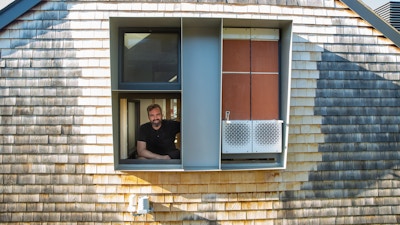The Vesma team is making big strides toward shaking up the air conditioning market

As average global temperatures continue to climb, the market for air conditioning is too: it’s estimated that worldwide demand for air conditioning will triple by 2050. If all those extra A/C units will use today’s standard, decades-old vapor compression technology, it could spell disaster for the planet.
Not only does vapor compression consume massive amounts of electricity (increasing the amount of fossil fuels burned), it also uses refrigerant chemicals whose end-of-life greenhouse effect is nearly 10,000 times more harmful than that of carbon dioxide.
Fortunately, a solution is in the works at the Wyss Institute and Harvard SEAS. cSNAP is a biologically inspired, indirect evaporative cooling technology that uses water instead of refrigerant chemicals and consumes up to 75% less electricity than standard vapor compression units. Evaporative coolers have been around for millennia, but currently only work in hot, dry climates. cSNAP’s innovation is a multi-chambered ceramic heat exchange unit that is strategically coated with a proprietary material that isolates moisture from air as it’s cooled, reducing the temperature without adding humidity to the air.
cSNAP was tested in real-world conditions for the first time at Harvard’s HouseZero in August 2022, on one of the hottest days of the year. It achieved a coefficient of performance (COP – the ratio between the produced cooling power and the power needed to run the system) above 8 on-site and made the room where it was installed noticeably cooler.
Additional advantages of the system include its ceramic material base and low water use, which make it appealing for low-resource and desert settings, as well as its slim form factor that allows it to be unobtrusively clipped onto the wall of a building, or installed into a window frame for easy retrofitting. cSNAP has attracted significant attention from partners and competitors in the residential cooling and HVAC industries, and has been covered by Scientific American, Harvard Magazine, Architect Magazine, The Washington Post, and more.
A more recent iteration of the system, which added a novel dehumidification technology to improve its cooling performance, was successfully tested at HouseZero in September 2023. The combined technology, called Vesma, has the potential to reach a COP of 10, whereas most standard A/C systems achieve a maximum of 3.5.
The Vesma team is initially focusing on the residential air conditioning market as the first of several promising applications. They are working to launch a startup to commercialize their technology, and are seeking inquiries from interested investors and partners.

Help us bring cSNAP to market
The cSNAP team is planning to launch a startup to commercialize their eco-friendly air conditioning technology within the next year. If you are interested in helping to accelerate the development of cSNAP and/or joining the team, please get in touch with Ally Chang.
